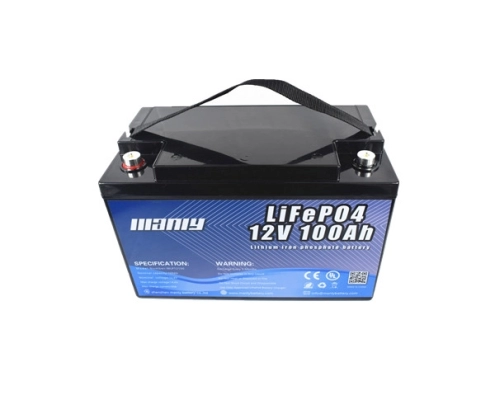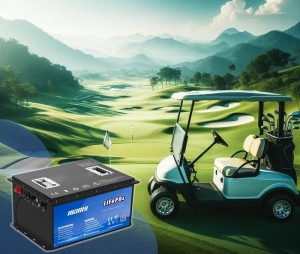Combien de temps durera une batterie de 100 Ah ?
Table des matières
- Combien de temps durera une batterie de 100 Ah ?
- Comprendre la capacité de la batterie
- Types de batteries 100 Ah
- Méthode détaillée pour calculer la durée de vie d'une batterie
- Comment calculer l'autonomie de la batterie : un guide pratique
- How Long Does 100Ah Battery Last in a Golf Cart
- How Long Will 4 Parallel 12v 100Ah Lithium Batteries Last
- Conclusion
- En savoir plus sur la batterie
Choosing the right battery and understanding how long it will last are crucial for both daily use and long-term planning. Whether you're powering a home, an RV, or any other device, knowing the battery capacity and how to calculate its run time ensures you have reliable power when you need it. This guide will walk you through the process of calculating the run time of a 100ah battery, explain important concepts like battery ah meaning, and discuss the differences between various types of 100Ah batteries. By the end of this guide, you'll have a clear understanding of how to manage your power needs effectively.


Comprendre la capacité de la batterie
Explication de la signification de la batterie AhBattery capacity tells us how much electric charge a battery can store. It's like a tank holding water. The unit we use to measure this is called amp hours (Ah) or milliamp hours (mAh). If you see a battery labeled with 100ah, it means it can deliver 100 amps for one hour or 10 amps for 10 hours. Think of amp hours as the size of the tank and the current (amps) as the water flowing out. A bigger tank (higher Ah) means more water (electricity) can flow for a longer time.Que signifie ah sur une batterie ? Clarification de la signification de la batterieSo, what does ah mean on a battery? Ah stands for amp hours, a way to measure battery capacity. It's crucial for understanding how long a battery will last under a specific load. For example, if you have a 100Ah battery, it means the battery can deliver 100 amps of current for one hour before it's empty. If your device only needs 10 amps, the same battery would last for 10 hours (100Ah / 10A = 10h). This is why ah battery meaning is essential when choosing the right battery for your needs.Let's break it down with an example. Imagine you have a 7Ah battery. If you use it with a device that draws 0.35 amps, you can calculate the runtime as follows:7Ah÷0,35A=20 heuresThis shows how long the battery will last with that specific load. Knowing what does ah mean on a battery helps you plan and manage your power needs effectively.Importance of amp hours explained in understanding battery lifeUnderstanding amp hours is key to predicting how long your battery will last. When we talk about amp hours explained, we mean how this unit helps us figure out the battery's lifespan under different loads. This knowledge is critical for anyone using batteries in their daily life, from homeowners to RV enthusiasts.For instance, if you're running a 12-volt device with a 12 volt lithium battery 100ah, you can use an amp hour calculator to estimate how long your battery will last. Suppose your device uses 5 amps. Here's the calculation:100UNh÷5UN=20heuresThis means the 100ah battery will last for 20 hours before needing a recharge. This simple math can make a big difference in planning your power usage.Knowing what is ah in battery and how to use it can save you from unexpected power shortages. It's also helpful for comparing batteries. A higher Ah rating generally means longer battery life, but it also depends on the current draw of your devices.When you understand amp hours explained, you can make better choices about which battery to buy. You can match the battery's capacity with your power needs, ensuring you have enough power for your devices. For example, a 100 amp lithium battery is suitable for high-demand devices, while a smaller battery might be enough for low-power needs.In summary, understanding battery capacity means knowing the battery ah meaning and how amp hours work. This knowledge helps you choose the right battery and use it efficiently. Whether you're powering a home, an RV, or any other device, knowing your battery's capacity and how to calculate its run time is essential for reliable power management.
Types de batteries 100 Ah
When it comes to 100Ah batteries, there are three main types: Batterie lithium-ion 100ah,Batterie LiFePO4 100ah, etBatterie au plomb 100ah. Chacune de ces batteries possède des caractéristiques uniques et elles sont utilisées dans différentes applications en fonction de leurs forces et faiblesses. Comprendre ces différences est crucial pour sélectionner la batterie adaptée à vos besoins.1. Overview of Different Types
Batterie au lithium-ion 100 Ah: Les batteries lithium-ion sont réputées pour leur haute densité énergétique et leur longue durée de vie. Ils sont couramment utilisés dans les appareils électroniques portables, les véhicules électriques et les systèmes d’énergie renouvelable. Ces batteries sont légères et peuvent stocker une grande quantité d’énergie dans un petit espace. Une batterie lithium-ion typique de 100 Ah peut fournir une source d’alimentation fiable pour diverses applications, ce qui en fait un choix populaire.100AhBatterie LiFePO4:Les batteries LiFePO4, ou lithium fer phosphate, sont un type de batterie lithium-ion qui offre une sécurité améliorée et une durée de vie plus longue. Ces batteries sont particulièrement connues pour leur stabilité et leur résistance à la surchauffe. Ils sont souvent utilisés dans des applications où la sécurité est une priorité absolue, comme dans les véhicules électriques, les systèmes d'énergie solaire et les alimentations de secours. Une batterie LiFePO4 de 100 Ah peut supporter plus de cycles de charge et de décharge que les autres batteries lithium-ion.Batterie au plomb 100Ah: Les batteries au plomb sont l'un des types de batteries rechargeables les plus anciens. Elles sont plus lourdes et plus volumineuses que les batteries lithium-ion, mais elles sont également plus abordables. Les batteries au plomb sont couramment utilisées dans les applications automobiles, les alimentations sans interruption (UPS) et les systèmes d'alimentation de secours. Bien qu’ils aient une durée de vie plus courte et une densité énergétique plus faible, ils sont fiables et rentables pour de nombreuses utilisations.2. Comparison Between Them and Their Specific Applications
Densité énergétique et poids:- Batterie au lithium-ion 100 Ah: Ces batteries ont une densité énergétique élevée, ce qui signifie qu'elles peuvent stocker plus d'énergie par unité de poids. Cela les rend idéaux pour les appareils portables et les véhicules électriques où le poids est un facteur critique.
- Batterie LiFePO4 100 Ah: Les batteries LiFePO4 ont également une densité énergétique élevée mais sont légèrement plus lourdes que les batteries lithium-ion standard. Cependant, leur sécurité améliorée et leur longue durée de vie les rendent adaptés aux applications stationnaires telles que le stockage de l'énergie solaire et l'alimentation de secours.
- Batterie au plomb 100Ah: Les batteries au plomb ont une densité énergétique plus faible, ce qui les rend plus lourdes et plus volumineuses. Ils ne conviennent pas aux applications où le poids est un problème, mais leur prix abordable en fait un bon choix pour les utilisations stationnaires et moins sensibles au poids.
- Batterie au lithium-ion 100 Ah: Généralement, ces batteries peuvent supporter entre 500 et 1 000 cycles de charge. Ils conviennent parfaitement aux applications nécessitant des cycles fréquents, telles que les véhicules électriques et les appareils électroniques portables.
- Batterie LiFePO4 100 Ah: Les batteries LiFePO4 excellent en termes de durée de vie, avec une plage de 1 000 à 2 000 cycles. Cela les rend parfaits pour une utilisation à long terme dans les systèmes d’énergie renouvelable et les véhicules électriques.
- Batterie au plomb 100Ah: Ces batteries ont une durée de vie plus courte, généralement autour de 300 à 500 cycles. Ils conviennent mieux aux applications dans lesquelles la batterie n'est pas cyclée fréquemment, telles que les systèmes d'alimentation de secours.
- Batterie au lithium-ion 100 Ah: Bien qu'elles soient généralement sûres, ces batteries peuvent présenter des risques si elles sont endommagées ou mal manipulées, notamment des risques d'incendie potentiels.
- Batterie LiFePO4 100 Ah: Ces batteries font partie des batteries lithium-ion les plus sûres, avec un risque de surchauffe et d'incendie bien moindre. Ils sont idéaux pour les applications où la sécurité est primordiale.
- Batterie au plomb 100Ah: Les batteries au plomb sont relativement sûres mais peuvent produire de l'hydrogène pendant la charge, ce qui nécessite une ventilation adéquate pour éviter les explosions.
- Batterie au lithium-ion 100 Ah: Ces batteries sont plus chères en raison de leur technologie avancée et de leur haute densité énergétique. Le coût initial plus élevé est souvent justifié par leurs performances et leur longévité.
- Batterie LiFePO4 100 Ah: Les batteries LiFePO4 sont également coûteuses, mais leur longue durée de vie et leurs caractéristiques de sécurité en font un investissement rentable pour de nombreux utilisateurs.
- Batterie au plomb 100Ah: Les batteries au plomb sont l’option la plus abordable. Leur coût inférieur les rend accessibles à un large éventail d’applications, malgré leurs performances inférieures.

Méthode détaillée pour calculer la durée de vie d'une batterie
Understanding how long a battery will last is important for planning and reliability. The run time of a battery is determined by several factors, including its capacity, the load connected to it, and the condition of the battery. Here, we’ll break down the process to calculate the run time for a 100ah battery.First, let's understand battery capacity. Battery capacity is measured in amp hours (Ah). A 100ah battery means it can provide 100 amps for one hour, or 10 amps for 10 hours. Pour calculer la durée de vie d'une batterie, vous utilisez la formule :Autonomie de la batterie (heures) = Capacité de la batterie (Ah) Charge (ampères)Autonomie de la batterie (heures)=Charge (ampères)Capacité de la batterie (Ah)Par exemple, si vous avez une batterie de 100 Ah et que vous connectez une charge de 10 ampères, la batterie durera :100UNh/10UN=10heuresCette formule simple vous aide à estimer la durée d'exécution sous différentes charges.1. Using an calculateur d'ampère-heurepour déterminer le temps d'exécution
An amp hour calculator is a useful tool that simplifies these calculations. By inputting the battery's capacity and the load, the calculator gives you an immediate estimate of how long the battery will last. This is especially helpful for those who might find manual calculations challenging.Par exemple, si vous disposez d’une batterie au lithium de 100 Ah et que vous la connectez à un appareil qui utilise 5 ampères, la calculatrice affichera :100UNh / 5A=20heuresCela signifie que la batterie de 100 Ah durera 20 heures avant de devoir être rechargée.Exemples de calculs pour les appareils courants
Let's go through some common examples to see how this works in real life.Exemple 1 : faire fonctionner un téléviseur- Supposons que le téléviseur utilise 2 ampères.
- Avec une batterie lithium 100ah :
- Un ordinateur portable peut consommer environ 5 ampères.
- Avec une batterie lithium 100ah :
- Les lumières des camping-cars peuvent utiliser 1 ampère.
- Avec une batterie lithium 100ah :
2. Factors Affecting Battery Life
While these calculations give you a basic idea, several factors can affect the actual run time of a 100ah battery:- État de la batterie: Les nouvelles batteries fonctionnent mieux que les anciennes. Avec le temps, la capacité d’une batterie diminue. Une batterie au lithium de 100 Ah en bon état peut vous donner près de 100 Ah, mais pas une batterie plus ancienne.
- Taux de décharge: Les batteries ont des taux de décharge différents. Par exemple, une batterie LiFePO4 de 100 Ah peut généralement se décharger à des taux plus élevés qu’une batterie au plomb sans perdre en efficacité. Cela signifie qu'une batterie LiFePO4 de 100 Ah peut fournir une durée de fonctionnement plus cohérente sur différentes charges.
- Température: Extreme temperatures can affect battery performance. At very low temperatures, the battery's efficiency drops, reducing the run time. For example, a 100ah lithium battery might only last half as long at -10°C compared to room temperature.
- Auto-décharge: Au fil du temps, les batteries perdent leur charge même lorsqu'elles ne sont pas utilisées. Les batteries au lithium ont un faible taux d’autodécharge, souvent de l’ordre de 2 % par mois. En revanche, les batteries au plomb peuvent perdre jusqu’à 4 % par semaine. Cela affecte la durée pendant laquelle la batterie peut conserver sa charge lorsqu'elle est stockée.
- Caractéristiques de charge: Certains appareils consomment plus d’énergie par intermittence. Un appareil avec un courant de démarrage plus élevé peut réduire la durée de fonctionnement de la batterie plus rapidement qu'un appareil avec une charge constante.
Comment calculer l'autonomie de la batterie : un guide pratique
When you need to figure out how long a 100Ah battery will last, there are several steps and factors to consider. This guide will walk you through the process using simple terms and examples.(For a precise and efficient calculation of battery runtime, the Lead Acid, Lithium & LiFePO4 Battery Runtime Calculator offers accurate and user-friendly results.)1. Understanding Battery Capacity in Watt-Hours
The first thing to know is how to convert the battery capacity from amp-hours (Ah) to watt-hours (Wh). Watt-hours are a better measure because they show the energy consumption directly.To convert amp-hours to watt-hours, multiply the amp-hours by the battery voltage. Most deep-cycle batteries work at 12 volts. For a 100Ah battery, the calculation is:Wh=Ah×TensionDonc,Wh=100×12=1200 wattheuresCela signifie que la batterie peut fournir 1 200 watts pendant une heure.2. Considering Depth of Discharge (DoD)
Next, we need to consider the Depth of Discharge (DoD), which is the percentage of the battery that can be safely used. For lead-acid batteries, the DoD is usually 50%. For LiFePO4 batteries, it's typically 100%.Pour une batterie au plomb :Capacité disponible = Wh×DoD=1200×0,50=600 wattheures=1200×0.50=600wattheuresPour une batterie LiFePO4 :Capacité disponible = 1 200 × 1,00 = 1 200 wattheures3. Accounting for Inverter Efficiency
Batteries provide DC power, but most devices use AC power, so an inverter is used to convert DC to AC. Inverters are not 100% efficient; they usually have an efficiency rating (ER) of about 95%.Pour une batterie au plomb :Capacité nette = Capacité disponible × ER=600×0,95=570 wattheures=600×0.95=570wattheuresPour une batterie LiFePO4 :Capacité nette = 1 200 × 0,95 = 1 140 wattheures4. Calculating Run Time
Now that we have the net capacity, we can calculate the run time. You need to know the total power consumption of the devices you’re using, measured in watts.For example, if you're using a 50W lamp and a 50W speaker, the total load is:Charge totale = 50 W + 50 W = 100 WLa durée d'exécution correspond à la capacité nette divisée par la charge totale :Pour une batterie au plomb :Durée=Charge totaleCapacité nette=570 Wh / 100W=5.7heuresPour une batterie LiFePO4 :Durée=1140Wh/100W=11.4heures5. Practical Example
Let’s put this into a real-life scenario. Imagine you have a camping trip and you bring a 100Ah LiFePO4 battery, a 50W lamp, and a 50W portable speaker.- Convertir des ampères-heures en wattheures :100UNh×12V=1200Wh
- Considérez le DoD pour LiFePO4 :1200Wh×100
- Tenir compte de l'efficacité de l'onduleur :1200Wh×95
- Calculer la charge totale :50O+50O=100O
- Déterminez le temps d'exécution :1140Wh / 100W=11.4heures
How Long Does 100Ah Battery Last in a Golf Cart
Understanding how long a Batterie 100 Ah can last in a golf cart involves several factors, including battery type, usage patterns, and environmental conditions. A standard Lifepo4 golf cart battery with a capacity of 100Ah typically offers a balance between performance and longevity, making it a popular choice among golf cart owners. However, determining the actual runtime of a 100Ah golf cart battery requires a closer look at its specifications and how it is used in different scenarios.
1. What is the Life Expectancy of Golf Cart Batteries?
The golf cart battery life expectancy is influenced by multiple variables, such as battery type, usage frequency, and maintenance practices. Generally, the life expectancy of golf cart batteries ranges from 3 to 5 years for lead-acid batteries and can extend up to 8-10 years for lithium options like Lifepo4 golf cart batteries. Proper care and regular maintenance can help maximize golf cart battery lifespan, ensuring that your investment lasts as long as possible.2. Key Factors Influencing Golf Cart Battery Life
The golf cart battery lifespan is influenced by a combination of factors such as battery capacity, age, type, and maintenance practices. For example, batteries that are frequently deeply discharged, used in extreme temperatures, or stored improperly will experience a shorter lifespan. Ensuring that the batteries are used under optimal conditions can significantly prolong their longevity.- Capacité de la batterie: The capacity, measured in amp-hours (Ah), indicates how much energy the battery can store. A 100Ah battery can theoretically supply 100 amps for one hour or 10 amps for 10 hours. However, real-world factors such as driving conditions and terrain can alter this.
- Battery Age: Over time, batteries naturally degrade. This process is accelerated by deep discharges, extreme temperatures, and poor charging habits. An aging battery will have a reduced ability to hold a charge, resulting in shorter runtime.
- Type de batterie: Lithium batteries, such as Lifepo4 golf cart batteries, generally have a longer lifespan compared to traditional lead-acid batteries. They also have lower maintenance needs and better energy efficiency.
- Usage Patterns: Frequent and high-current discharges, as well as running the battery to extremely low levels, can shorten its lifespan. Golf carts used on hilly terrain or for towing purposes will put more strain on the battery.
- Conditions environnementales: High temperatures can accelerate chemical reactions inside the battery, causing faster wear. Cold temperatures can reduce the battery's capacity, impacting performance and lifespan.
- Maintenance Practices: Regularly checking battery connections, cleaning terminals, and maintaining proper electrolyte levels (for lead-acid batteries) can prevent premature battery failure.
3. How Long Does a 100Ah Battery Last in a Golf Cart?
A 100Ah golf cart battery will typically last between 4 to 8 hours on a single charge, depending on driving conditions and usage. If the golf cart operates on flat terrain with a moderate load, you can expect the battery to last closer to 8 hours. On hilly terrain or with a heavier load, the battery’s runtime may be reduced to around 4 hours.For instance, if a golf cart uses an average of 10 amps per hour, a fully charged 100Ah Lifepo4 golf cart battery would provide approximately 10 hours of use (100Ah ÷ 10A = 10 hours). However, it’s important to note that real-world usage varies due to factors such as speed, terrain, and the cart's total weight.4. When to Replace Golf Cart Batteries?
You should replace golf cart batteries when their performance noticeably declines, such as when the cart’s runtime decreases significantly or when the battery struggles to hold a charge. Physical signs such as swelling, leaking, or cracked casings are also strong indicators that the batteries are near the end of their lifespan.Replacing golf cart batteries can be a significant investment, so it's crucial to know when it’s time to upgrade:- Reduced Runtime: If you notice a significant drop in the golf cart’s runtime after a full charge, this is a strong indicator that the battery capacity is decreasing.
- Slower Charging: When a battery takes significantly longer to charge than usual, it may be reaching the end of its lifespan.
- Physical Deformation: Swelling, cracking, or leakage are signs of internal damage. If you see these, it’s time to replace golf cart batteries immediately.
- Low Voltage Readings: Consistently low voltage readings after a full charge indicate that the battery can no longer hold its charge effectively.
- Frequent Need for Charging: If you find yourself charging the battery more frequently than before, it means the battery’s ability to store energy has diminished.
5. How to extend the life of golf cart batteries?
To extend the golf cart battery lifespan, it’s important to charge the batteries properly, keep them clean, and avoid deep discharges. Using a charger specifically designed for the battery type and storing the batteries in a cool, dry place will also help ensure they last as long as possible.Taking good care of your golf cart batteries can significantly extend their lifespan:- Regular Charging: Always recharge the batteries after each use. Avoid letting the battery drop below 20% charge as deep discharges can shorten its lifespan.
- Use the Right Charger: Use a charger specifically designed for your battery type. For Lifepo4 golf cart batteries, using a compatible charger will help maintain the battery’s performance.
- Évitez les températures extrêmes: Store and use your batteries in temperatures between 50°F and 77°F (10°C and 25°C) to minimize wear and tear.
- Nettoyer les bornes de la batterie: Corrosion on the terminals can lead to poor electrical connections. Regular cleaning with a brush and baking soda solution will ensure good conductivity.
- Check Water Levels: For lead-acid batteries, regularly check and top up the water levels with distilled water. Low water levels can damage the battery's internal components.
How Long Will 4 Parallel 12v 100Ah Lithium Batteries Last
The runtime of 4 parallel 12v 100Ah lithium batteries depends on the total energy capacity and the power consumption of the connected devices. When configured in parallel, these batteries provide a total energy capacity of 4800 watt-hours (Wh). By dividing this capacity by the device's power draw in watts, you can calculate the approximate runtime.1. How Parallel Connection Increases Battery Capacity
In a parallel configuration, the capacity of the battery pack increases while the voltage remains constant. For 4 parallel 12v 100Ah lithium batteries, the total capacity is calculated as follows:- Tension: 12 volts (unchanged in parallel connection)
- Total Capacity: 100 Ah×4=400 Ah
- A device drawing 100 watts will run for approximately 48 hours:
2. 4 Parallel 12v 100Ah Lithium Batteries Runtime Calculation Chart
The following chart provides runtime estimates for devices with varying power consumption levels, assuming optimal conditions (e.g., 77°F or 25°C and 100% Depth of Discharge (DOD)):| Device Power Consumption (W) | Runtime (Hours) |
|---|---|
| 50 | 96 |
| 100 | 48 |
| 200 | 24 |
| 500 | 9.6 |
| 1000 | 4.8 |
- Temperature Effects:
- Cold Weather: At lower temperatures (below 32°F or 0°C), battery efficiency may drop by up to 20-30%. This reduces the available capacity, meaning a device drawing 100W would run for approximately 33-38 hours instead of 48.
- Hot Weather: High temperatures (above 104°F or 40°C) can also degrade performance over time, though the immediate impact is less severe compared to cold conditions.
- Depth of Discharge (DOD):
- La plupart12v 100Ah lithium batteries are designed for deep discharge, but manufacturers often recommend a DOD of 80% for maximum lifespan. Using only 80% of the total capacity (3840Wh instead of 4800Wh), a 100W device would run for approximately 38.4 hours.
Adjusted Runtime Calculation Chart (Considering Temperature and 80% DOD)
To better reflect real-world conditions, here’s an updated runtime chart accounting for a typical 80% DODetmoderate temperature variations:| Device Power Consumption (W) | Runtime (Hours) (80% DOD) | Runtime (Hours) (Cold Weather - 70% Efficiency) |
|---|---|---|
| 50 | 76.8 | 67.2 |
| 100 | 38.4 | 33.6 |
| 200 | 19.2 | 16.8 |
| 500 | 7.68 | 6.72 |
| 1000 | 3.84 | 3.36 |
- Battery Efficiency in Cold Weather: At low temperatures, lithium-ion batteries experience reduced chemical activity, which directly lowers their efficiency. For users in cold climates, it's crucial to store batteries in insulated or heated compartments to maintain runtime and capacity.
- DOD and Lifespan:
Frequently discharging a battery to its full capacity can shorten its lifespan. For instance:
- 80% DOD ensures a longer lifecycle, typically 2000-3000 charge cycles.
- 100% DOD might reduce the lifespan to around 1500 cycles.
- Load Variability: Higher power consumption (e.g., 500W or more) amplifies the effects of temperature and DOD on performance. In such cases, selecting a slightly oversized battery system can help mitigate runtime reductions.
3. Application Scenarios: Runtime for 4 Parallel 12v 100Ah Lithium Batteries
This battery configuration is suitable for various scenarios that require reliable, long-lasting energy storage:- Solar Power Systems: In solar setups, 4 parallel 12v 100Ah lithium batteries provide ample storage for backup power. For instance, they can support a 200W load (e.g., lights and small appliances) for 24 hours continuously.
- Recreational Vehicles (RVs): For RV enthusiasts, this setup can power a combination of appliances such as refrigerators, fans, and lights. A typical 300W load would last approximately 16 hours.
- Off-Grid Applications: For remote cabins or off-grid homes, this system ensures continuous power for essential devices like water pumps or communication equipment.
- Backup Power for Critical Devices: Hospitals or IT facilities can use these batteries to power critical systems during outages. A 500W load, for example, would run for nearly 9.6 hours.




















